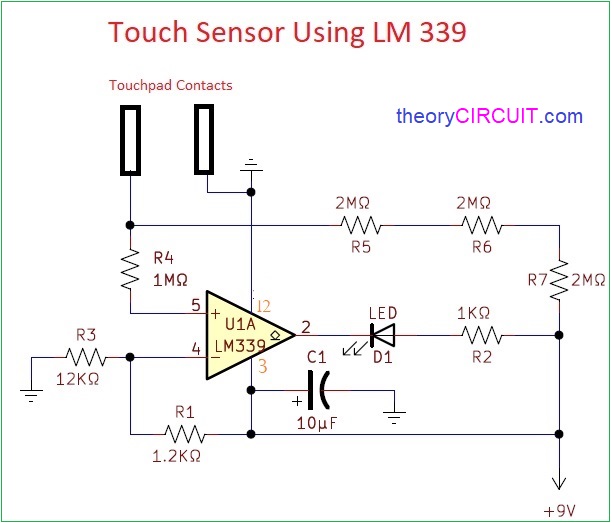Last Updated on March 16, 2024
Simple Touch Sensor Circuit designed by using IC LM339, As we know LM339 contains Quad differential Comparators that are operates from a single power supply source. This Touch Sensor using LM339 utilize few external components and two conductive touchpad contacts. Here one touch pad is connected with Ground and another one is connected with non inverting pin 5 with limited bias and floating.
Touch sensing switch or sensor can be employed in different levels of application, this sensor circuit is capable of doing non critical application and tasks. This circuit operates in comparator mode, hence small changes in inverting or non inverting input may lead to change of output state.
Circuit Diagram
BOM
| S.NO | Designator | Value | Quantity |
| 1 | U1A | IC LM 339 | 1 |
| 2 | R1 | 1.2KΩ | 1 |
| R2 | 1KΩ | 1 | |
| R3 | 12KΩ | 1 | |
| R4 | 1MΩ | 1 | |
| R5,R6,R7 | 2MΩ | 3 | |
| 3 | C1 | 10μF | 1 |
| 4 | D1 | LED | 1 |
Construction and Working
IC LM339 from Texas Instruments comes in different packages and size. In this touch sensor circuit we use PDIP (14) package, and also we use single supply source 9V, this circuit works as a comparator so we use inverting input pin 4 as a reference and non inverting pin 5 as a floating input.
Here pin 4 or inverting input connected with +9V through R1 and Balanced to Ground through R3 Resistor. Due to its non inverting mode of operation the pin 5 (non Inverting) potential remains higher than pin 4. Hence the output pin gives state high, when the touch plate touched by anyone then the pin 5 voltage Grounded by that person and potential of pin 5 goes below the pin 4 and output state changes to low and gives near ground output. Then the LED D1 starts to glow and indicates the touch event.
In this circuit output current is determined by the load and pull-up Resistance and logic and pull voltage. Capacitor C1 acts as a DC Voltage filter, If you are using filtered DC supply as a voltage source then we don’t need this component. Use Copper plate as a Touchpad contacts for best sensing response.

